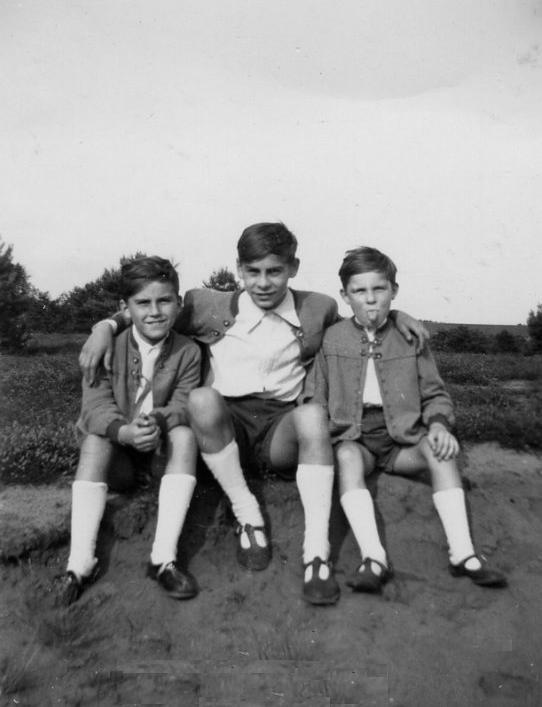
German Sandals: Accompanying Clothing

Figure 1.--Here we see three unidentified German boys wearing "T"-strap sandals with white kneesocks. The boys werar Tracht jackets. Two of the boys look to gbe brothers. The third boy may be a cousin. One boy seems not as happy as the others to hsve his picture taken.
|
|
Certain styles of clothes were commonly worn with sandals by German boys. Here there were very substantial changes over time. A factor were the social class connotations before Workd War II and the more widespread popularity of sandals after the War. At first we continue to see closed-toe sandals, but then open-toe sandals become more important. Another factor is the association of sandals with warm weather wear and thus seasonal summer styles. Most German boys wore sandals with short pants. Some boys in the 1980s and 90s might be seen wearung casual long pants, like jeans, with sandals. By far the dominte pattern was to wear sandals with short pants. This was in part because of their popularity as warm weathr summer wear. This was true, however, even in the 1920s and 30s when boys commonly wore short pants all year round. Generally speaking as German boys have come to more commonly wear long pants, it has become more common to see boys wearing sandals with long pants. We do not generally see sandals being worn with
suits, but here age was a factor. An exception for some reason was Tracht, at least the Tracht worn by younger boys. White socks, both ankle socks and knee socks seem to be popular with sandals. German boys have worn sandals both with and without socks. Even though sandals came to be warm weather clothing, it has been much more common to wear them with socks. This was in fact a common European style. American boys, in contrast, were much more likely to wear sandals without socks.
Shirt
Suits
We do not generally see sandals being worn with
suits, but here age was a factor. An exception for some reason was Tracht, at least the Tracht worn by younger boys.
Pants
Most German boys wore sandals with short pants. Some boys in the 980s and 90s might be seen wearung casual long pants, like jeans, with sandals. By far the dominte pattern was to wear sandals with short pants. This was in part because of their popularity as warm weathr summer wear. This was true, however, even in the 1920s and 30s when boys commonly wore short pants all year round. Generally speaking as German boys have come to more commonly wear long pants, it has become more common to see boys wearing sandals with long pants.
White socks, both ankle socks and knee socks seem to be popular with sandals.German boys have worn sandals both with and without socks. Even though sandals came to be warm weather clothing, it has been much more common to wear them with socks. This was in fact a common European style. American boys, in contrast, were much more likely to wear sandals without socks.
HBC

Navigate the Boys' Historical Clothing Sandal Pages:
[Return to Main sandal page]
[Return to Main shoe page]
[Return to Main German page]
[German closed toe sandals]
[German open toe sandals]
Navigate the Boys' Historical Clothing Strap Shoe-related Pages:
[Return to the Main sandal page]
[White knee socks]
[Sand shoes]
[Pinafores]
[Smocks]
[Kilts]
[Ringlet curls]
[Fauntleroy suits]
[Buster Brown suits]
[Ring bearers]
Navigate the Boys' Historical Clothing Web Site:
[Introduction]
[Activities]
[Biographies]
[Chronology]
[Clothing styles]
[Countries]
[Bibliographies]
[Contributions]
[FAQs]
[Glossaries]
[Images]
[Links]
[Registration]
[Tools]
[Boys' Clothing Home]
Created: 9:13 PM 1/27/2010
Last updated: 9:13 PM 1/27/2010



